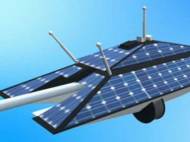Robot being developed to inspect the aging power lines
 Researchers at the Electric Power Research Institute, an independent nonprofit research organization for the utility sector, have designed a prototype of robot which will be used to inspect the power lines. Current way power lines are being monitored (in larger countries) is by helicopter which gathers data about warmth of the lines. This automated way to monitor power lines could bring more efficiency with lower cost.
Researchers at the Electric Power Research Institute, an independent nonprofit research organization for the utility sector, have designed a prototype of robot which will be used to inspect the power lines. Current way power lines are being monitored (in larger countries) is by helicopter which gathers data about warmth of the lines. This automated way to monitor power lines could bring more efficiency with lower cost.
The rectangular robot prototype weights 63.5kg (140 pounds) and its length is 1.82m (6 feet). It uses rollers to clamp onto and move along a line. It can maneuver past towers, known as pylons, using cables built into newer towers or retrofitted onto old ones. The robot is equipped with a high-definition camera and sensors that can detect overgrown trees by using image analysis to see if there is something different with the structure compared to an earlier picture taken from the exact same spot. Being able to remotely spot high-risk trees, which are the top cause of electrical outages, is important to utilities (the big August 2003 blackout in US was triggered by a poorly trimmed tree).
The prototype robot will also make sure there are no faulty connections that can cause overheating, and listen for electromagnetic “noise” that might indicate other problems with equipment. It could also retrieve data from sensors that are already connected to equipment in the field but which normally rely on helicopter or ground visits to get the information.
The device rolls almost 5 kilometers per hour (about three miles per hour) along a high-lying “shield wire” (a wire that protects the main transmission lines below from lightning strikes). Initially, the plan to power the robot involved covering its surface with solar cells that would charge a lithium polymer battery inside. “We decided instead to harvest power flowing through the shield wire itself,” said Andrew Phillips, director of power transmission research at the institute, who explained that the shield wire picks up some power flow from the nearby transmission lines through electromagnetic induction. However, they plan to solar cells will still be used for backup power.
In the most remote areas, raw data that has been collected will be sent back to the utility through a satellite link. Higher bandwidth information, such as digital images, will be transmitted through cell-phone signals when the robot gets closer to population centers. The researchers figure that each robot could cover almost 130 km (80 miles) of line twice a year.
There are other technologies being developed to lessen the costs and improve performance in power line checking. However, Phillips claims the problem with aerial drones (one of the alternatives) is in the U.S. Federal Aviation Authority which has strict rules on how and when they can be used because of a potential impact if they malfunctioned. A line-crawling robot poses less of a threat and can travel the lines all year and, if necessary, even at night.
The robot still needs a lot of field testing. Unfortunately, the researchers claim the first commercial test is expected to take place as early as 2014 along the Potomac-Appalachian Transmission Highline, a new transmission corridor being built by Allegheny Energy and American Electric Power in Columbus, OH.









Very useful as a future option.
Dr.A.Jagadeesh Nellore(AP),India
There are many methods of line inspection from drive-bys, to using drones or manned planes or helicopters with scanners. The use of a robot to crawl the line – and move itself over the various types of towers – is a very promising invention.
The one at the EPRI appears to be on a path to it’s first practical use in 2014. Japan has one now.
For further information, check TheRobotReport.com which will have an article on the state of the art in a short while.
author
If you are referring to HiBot’s Expliner I am familiar with it. We planed to publish an article about it with a reference back to this article.
Hi,
Regarding the Japanese one, HiBot’s Expliner is the one I was thinking about. But there are others being developed also. And other methods as well. If you have a list of others working on the problem, I would appreciate it in that I am trying to come up with all the projects worldwide which are attempting to reduce costs and increase efficiencies in transmission line inspection and maintenance.
Frank
All three high-voltage transmission line maintenance robots are detailed – with links to the sources – on The Robot Report. Expliner, LineScout and EPRI’s as-yet unnamed robot.
Sounds like a good business opportunity.
Anybody know of additional transmission line inspection robots? Or of businesses providing the service and using robots?
Thanks.